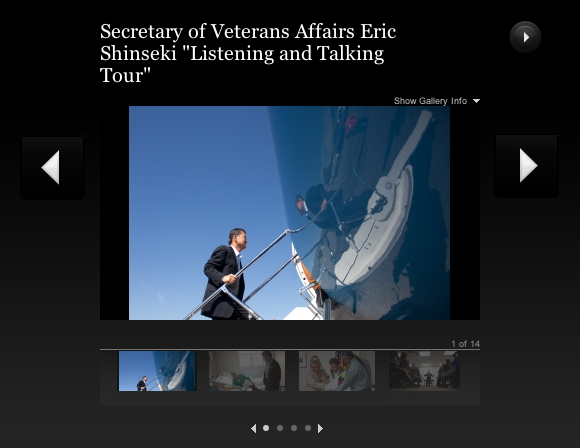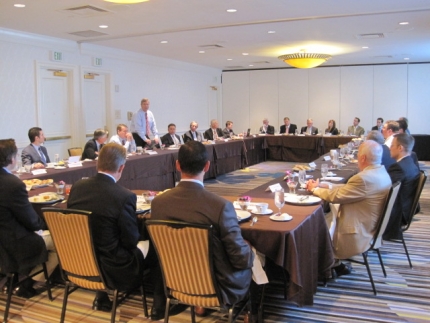White House Rural Council Blog
Rural Tour Day Two: Economic Forum in Peosta, Iowa
Posted by on August 16, 2011 at 10:14 AM EDT
After a full day spent talking and listening to Americans at town halls in Cannon Falls, Minnesota and Decorah, Iowa yesterday, this morning the President's economic bus tour pulls into Peosta, Iowa for the White House Rural Economic Forum at Northeast Iowa Community College. President Obama and members of his Cabinet will meet with private sector leaders, farmers and small business owners to discuss ideas to grow the economy, accelerate hiring and spur innovation in small towns across the country.
The focus of the forum is how we can create good jobs that put more Americans back to work, and President Obama will announce new job initiatives for rural America that will do just that. The initiatives will include recommendations from the White House Rural Council that include helping small businesses in rural areas access capital, expanding rural job search and training services and increasing rural access to health care workers and technology.
Watch President Obama's opening remarks at 12:50 p.m. EDT and closing remarks at 3:30 p.m. EDT on WhiteHouse.gov/live to learn more about the President's plan to create jobs in small cities and towns across America.
Rural Veterans and the Tyranny of Distance
Posted by on August 3, 2011 at 8:00 AM EDTAt the Department of Veterans Affairs, Secretary Shinseki often talks about the tyranny of distance – the distance that often separates Veterans from care at their nearest VA medical facilities. For about 3.3 million Vets, or 41 percent of the total enrolled in VA’s health care system, distance is more than a challenge. Distance can mean rural Veterans don’t have access to the care and services they’ve earned.
Secretary Shinseki made it clear – this summer, he wanted to hear from Veterans in the hardest to reach places. “I know from previous experience that sitting in Washington with a 2,000-mile screwdriver trying to fine tune things at the local level never works,” he said. So, we hit the road to learn firsthand.
From the plains of North Dakota and Montana to the isolated island of Guam, Veterans from rural areas talked with Secretary Shinseki about what’s working and what the department can do better. To many Veterans, it was clear VA has shifted its approach to be more accessible. But we also quickly learned that standard definitions like “urban, rural, and highly rural” may not be exact enough. Often, “remote, extreme rural, and inaccessible” is more accurate.
The “inaccessible” category would definitely include Kwigillingok, Alaska, or Kwig, located in the far reaches of Central Yup’ik near the Bering Sea. On Memorial Day, Secretary Shinseki visited Kwig to meet and honor living members of the Alaska Territorial Guard, who served bravely during World War II. No roads lead to Kwig, so the trip wasn’t easy. We hopped on a flight in Anchorage, and connected in the small town of Bethel – about 1,000 miles roundtrip. When we finally landed on the dirt landing strip in Kwig, villagers on all-terrain vehicles appeared from all over to give us rides to the village center.
White House Roundtable Meeting with Rural Leaders
Posted by on July 28, 2011 at 4:53 PM EDTEd. Note: Cross-posted from the USDA blog.
This week, I led a meeting in the Roosevelt Room at the White House with leaders of a host of rural organizations to discuss the White House Rural Council. The White House Rural Council, which was established by President Obama on June 9, 2011, will build on this Administration’s unprecedented efforts to spur job creation and economic growth in rural America. Along with Jon Carson, the Director of the Office of Public Engagement and Doug McKalip of the White House Domestic Policy Council, we discussed the Council’s efforts to improve coordination among federal agencies. We focused in on ways to help better leverage existing federal resources in rural America – and on how to facilitate private-public partnerships that can move the needle in building stronger rural communities.
The meeting was a chance for me to listen to our rural partners on the issues that need to be addressed and discuss potential solutions. Some of the key issues raised included the need to coordinate more with our federal partners on health care, broadband, and other critical infrastructure; how to increase the availability of capital and lending to rural businesses and families; efforts to remove barriers to young and beginning farmers; and strategies for establishing better partnerships with states, tribes, local governments and the private sector. Many of the leaders gathered also expressed appreciation for the renewed focus on rural America and the importance the White House has placed on these issues.
Winning the Future by Supporting Local Innovation
Posted by on July 28, 2011 at 3:15 PM EDTToday, I was proud to announce that we are making $95 million available in Regional and Community Challenge grants to support local efforts to build more livable and sustainable communities that ensure that all Americans can afford to live in places with access to employment, schools and public transit options.
But that’s not all these efforts represent. They show that President Obama recognizes that in world where flexible workplaces win, where flexible minds win and where flexible economies win, communities need a flexible federal partner that’s responsive to local needs.
With this funding, we’re building on the $170 million in grants we awarded last fall with our partners from the Department of Transportation to offer a different kind of partnership to local communities. Rather than the “one-size-fits-all” rules and regulations that too often ignored the unique needs of every community and created barriers to growth, the Partnership for Sustainable Communities is helping drive innovation at the local level and leveraging the public, private, and philanthropic investment communities need to thrive.
Learn more about Rural, Urban PolicyMile High City with Mountains of Ideas
Posted by on July 5, 2011 at 11:08 AM EDTLast week, I met with 20 business leaders from all over Colorado at a White House Business Council roundtable in Denver. It was an opportunity for me and my Colorado staff to get feedback on government programs, policies, and innovative ideas that are working to help create jobs – as well as ones that could be improved. Other Cabinet officials and top White House staffers have hosted more than 100 of these sorts of roundtables around the country. And over the coming weeks we will be holding these conversations in rural areas.
In Denver, I heard from business leaders who discussed the value of President Obama’s tax policies for businesses of all sizes, and appreciated the administrations work to better partner with the business community. We had a productive dialogue about how the pending trade agreements with South Korea, Columbia and Panama will benefit local agricultural producers, with the potential to create hundreds of jobs in Greeley, Colorado and other towns. And we discussed how resorts might form partnerships on recreation to make better use of forests and other natural environments to help create jobs in communities throughout the Rocky Mountains.
Everyone in the room agreed that there are incredible opportunities for growth in the economy as long as we believe in the strength and determination of the American people to work hard and innovate.
Collaborating with Tribes through the White House Rural Council
Posted by on July 1, 2011 at 11:55 AM EDTOn June 9th, President Obama signed an Executive Order establishing the first White House Rural Council. While rural communities face challenges, they also present economic potential. The Council will address these challenges, build on the Administration’s rural economic strategy, and improve the implementation of that strategy.
The Council, chaired by Secretary of Agriculture Tom Vilsack, was established to focus on policy initiatives for Rural Americans and will coordinate to increase the effectiveness of federal engagement with tribal governments. According to the 2010 U.S. Decennial Census, 42.6 percent of all Native Americans live in rural areas. In addition, some reservations face unemployment rates of up to 80 percent. The Council will work across federal agencies to address these challenges and promote economic prosperity and quality of life in Indian Country and across rural America. The Council will work to break down silos and find areas for better collaboration and improved flexibility in government programs and will work closely with state, local and tribal governments, non-profits, and the private sector to leverage federal support.
Plans are already underway for the Council to address ways to expand access to capital in rural communities, including an examination of the unique challenges facing Indian Country in increasing the flow of credit to Indian reservations. Economic development and job creation in Indian Country—and in all other sectors of the U.S. economy—depend on access to capital. When credit-worthy business owners can easily borrow to finance business start-up and expansion, the economy thrives. One thing we hear from tribal leaders, however, is that borrowing money for business development in Indian Country is difficult. The reasons range from difficulties in using tribal land as collateral, to the small number of lending institutions serving Indian Country, to lenders’ perceptions that lending to tribal members or tribal governments is risky.
Learn more about Rural
- &lsaquo previous
- …
- 5
- 6
- 7
- 8
- 9
- 10
- 11
- 12
- 13
- …
- next &rsaquo
White House Blogs
- The White House Blog
- Middle Class Task Force
- Council of Economic Advisers
- Council on Environmental Quality
- Council on Women and Girls
- Office of Intergovernmental Affairs
- Office of Management and Budget
- Office of Public Engagement
- Office of Science & Tech Policy
- Office of Urban Affairs
- Open Government
- Faith and Neighborhood Partnerships
- Social Innovation and Civic Participation
- US Trade Representative
- Office National Drug Control Policy
categories
- AIDS Policy
- Alaska
- Blueprint for an America Built to Last
- Budget
- Civil Rights
- Defense
- Disabilities
- Economy
- Education
- Energy and Environment
- Equal Pay
- Ethics
- Faith Based
- Fiscal Responsibility
- Foreign Policy
- Grab Bag
- Health Care
- Homeland Security
- Immigration
- Innovation Fellows
- Inside the White House
- Middle Class Security
- Open Government
- Poverty
- Rural
- Seniors and Social Security
- Service
- Social Innovation
- State of the Union
- Taxes
- Technology
- Urban Policy
- Veterans
- Violence Prevention
- White House Internships
- Women
- Working Families
- Additional Issues



